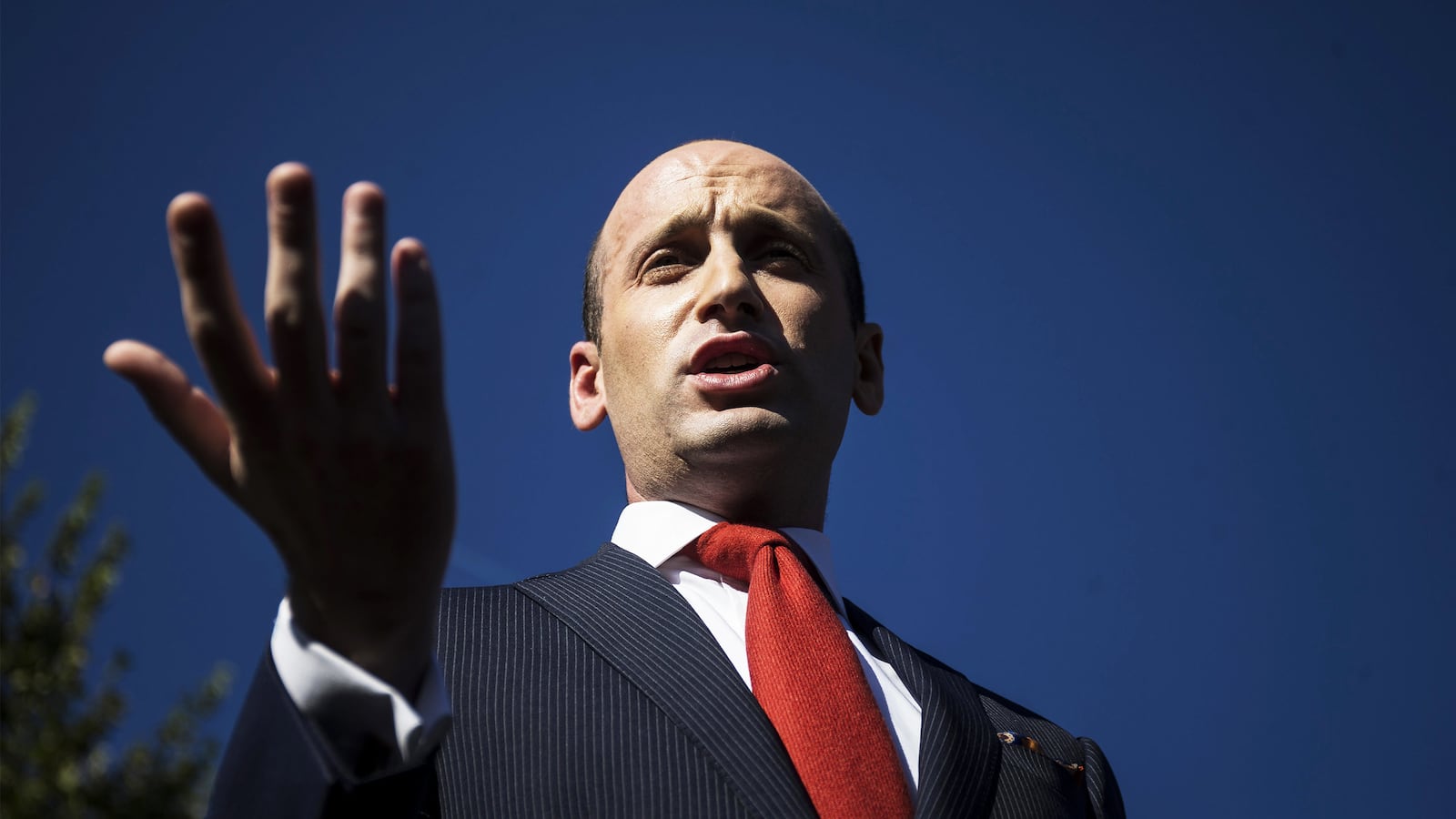On Jan. 13, 2017, Barack Obama's homeland security adviser Lisa Monaco led a disaster exercise for the Trump transition team. She went over deadly crises and how to respond to them: a hurricane, a cyberattack and a pandemic.
Trump’s top speechwriter and senior adviser Stephen Miller sat beside his predecessor on immigration policy, Cecilia Muñoz. He fiddled with his phone. He seemed distracted. During a break, Muñoz asked if he had questions. Miller said yes. He was curious if she had advice for avoiding interference from the National Security Council. "How do you make sure you're the person running the show?" she recalled him asking.
Muñoz, taken aback by the question from the 31-year-old public relations flack, explained that collaboration with the NSC and others was crucial because different officials possess unique expertise that could be critical for saving American lives. In response, she said, he chuckled.
“No matter how you feel about the people coming in, you really want them to be on their game if there’s a pandemic,” she told me last June. “I’m incredibly grateful there hasn’t been a pandemic.”
Now, as COVID-19 kills tens of thousands of Americans and cripples the economy, her fears have come to pass. “They’re being guided by ideology,” she says. For Miller, a far-right provocateur, running the show meant waging a battle he had been fighting since his youth in coastal Santa Monica, California: targeting non-white migrant children, their parents and their supporters.
President Trump says his border crackdown is about national security. But Miller, his immigration policy architect, revealed his priority in a 2016 Breitbart radio interview. Steve Bannon asked him: “Isn’t the beating heart of this problem right now, the real, beating heart of it … not illegal immigration, as horrific as that is, and it’s horrific … [but] legal immigration?” Miller replied, “Yes, it’s mind-boggling … immigration is supposed to be interrupted with periods of assimilation and integration.”
The White House’s pandemic response is fulfilling Miller’s fantasies. Rather than focusing on making testing as widely available as possible, the administration has focused on ending asylum, suspending green cards and canceling work visas.
Trump’s photo op at the wall in Yuma, marking the 200th mile of border wall construction, is a spectacle distracting from the real substance of his border crackdown: an unprecedented assault on legal immigration. Only three of the 200 border wall miles are in new places; the rest are replacement barriers. “We prevented a Coronavirus catastrophe on the southern border,” Trump said. (In fact, the U.S. has more cases than Mexico.)
In 2018, I filed a Freedom of Information Act request that revealed the dismal performance of all of Trump's border wall prototypes during testing. The wall is a symbol, manufacturing the illusion that Trump cares about criminals and rapists. The real target of this administration are the desperate and the destitute. Human apprehensions are down, but drug trafficking has increased, according to DHS.
Miller’s classist and racist reading preferences tell the story. In 2015, he promoted Jean Raspail’s The Camp of the Saints, a white supremacist book published in 1973 about the end of the white world, destroyed by poor non-white families described as “a suffering, stinking mob” with “monster children.” The title comes from the Book of Revelations, in which Satan and his bestial armies storm God’s chosen city. Miller’s ties to the book and white nationalist websites was reported by the Southern Poverty Law Center last fall, leading to calls for Miller’s resignation. But Trump kept him close, even attending his February wedding as COVID-19 spread.
Few understand that The Camp of the Saints is not only racist but also endorses violence against non-white people because of the alleged existential threat of their refusal to assimilate. The novel’s heroes make statements calling for slaughter of the Black and Brown characters, like: “If only he’d go the next step, and tell them to shoot, tell them to blast the crowd to hell!” and “No hope, Mr. Mayor. Unless you kill them all, that is, because you’ll never change them.” They lament the West’s failure “to turn its Christian love to hate.”
In a 1982 preface, Raspail made his sympathies with those bloodthirsty characters explicit, promoting the conspiracy theory of white genocide used by white terrorists to justify massacres: “Our hypersensitive and totally blind West . . . has not yet understood that whites, in a world become too small for its inhabitants, are now a minority and that the proliferation of other races dooms our race, my race, irretrievably to extinction in the century to come, if we hold fast to our present moral principles.”
Trump is the hero of Raspail’s racist dreams. When an exodus of Central American asylum seekers approached the U.S. in 2018, Trump tweeted: “This is an invasion of our Country and our Military is waiting for you!” Shoot them in the legs, he reportedly said of migrants. Trump’s approach to Black Lives Matter mirrors his approach to immigrants. “When the looting starts the shooting starts,” Trump said of Black Lives Matter protesters last month.
Miller’s religious zeal for this rhetoric and his white nationalist agenda has come at the expense of homeland security, according to current and former officials. From his earliest days in the White House, Miller transformed the Department of Homeland Security—with its sweeping mandate to protect the homeland—into an immigration weapon. Special agents investigating domestic terrorism and trafficking found their work undermined by the narrowed focus on non-criminal migrants. Miller’s purge of DHS last year served as a warning for top officials: stay focused on migrants, or else. Key positions are vacant or held by people in an acting capacity, such as acting secretary Chad Wolf. Former Trump DHS spokesman David Lapan said, “They’re fighting with one hand tied behind their backs.”
The focus on legal immigrants promotes the false but politically salient idea that foreigners are bad for America’s safety, health and prosperity. Immigrants perform vital functions in health care, food production and more. America’s elderly and most vulnerable rely on them. More than a quarter of direct care workers and 30 percent of nursing home housekeeping workers are immigrants.
Miller’s own grandmother, Ruth Glosser, relies on their care. She tested COVID-19-positive in March in an assisted living residence in North Hollywood, according to Miller’s uncle David Glosser. At age 97, she survived the infection with the help of people from Mexico, Central America and the Philippines who risked exposure to the virus. The virus left her with accelerated neurological and pulmonary deterioration, and she has been on hospice care for the past month. “Her life depends on the very people whose interests the administration has acted against,” said Glosser. “They’re real people, and perform real vital functions in our society… I’m very grateful for the care they’ve given her.”
Before the pandemic, Miller had already succeeded in nearly eliminating asylum at the southwest border, slashing refugee admissions to record lows and cutting green cards for low-income families. Protections for youths known as Dreamers were revoked—a decision the Supreme Court recently weighed in on against Trump. Thousands of children were separated from asylum-seeking parents. These steps disproportionately impacted people from non-white countries.
The pandemic is in some ways a dream come true for Miller. Trump has repeatedly threatened to close the border to everyone coming from Latin America, including people fleeing persecution. But it wasn’t until the coronavirus hit that Trump could turn them all away.
And since Trump can no longer use a strong economy to argue for reelection, he’s going to rely more heavily on Miller. The crackdown on legal immigrants, and on their supporters, will intensify in the coming months. Miller will be running the show.








